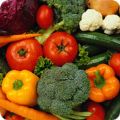|
Trying to lose weight while eating enough to support vigorous endurance or strength training can be a very tricky business. Cutting too many calories can cause the body to breakdown muscle tissue to meet its energy needs, and make it impossible to replenish energy reserves in time for your next workout. In turn, both of these consequences can lower your metabolism, making it much more difficult to shed body fat and improve body composition. Most people who consistently exercise more than 60 minutes per day at high intensity levels need to adjust their nutrition plans in one or more of the following ways:
Nutrient Recommendations for Very Active People The following chart shows how active and very active people can adjust their intake of the three macronutrients (carbohydrates, protein and fat).
Note: To avoid performance declines, people attempting to lose weight while engaging in demanding athletic training should not reduce their calorie intakes by more than 10-20% (or by more than 500-1000 calories per day). For good health, total fat intake should not fall below 15% of total calories. Meal Contents & Timing for Very Active People The Pre-Exercise Meal: Your individual reaction should be the primary factor that determines what, when and how much you eat prior to exercise. For many, eating before exercise enhances performance—especially during long exercise sessions that can exhaust glycogen reserves. Since most people find it difficult to exercise with a full stomach, you should allow plenty of time for digestion (about 3-4 hours before exercise) in order to get the energy benefits of a pre-exercise meal. For long bouts of higher intensity exercise, studies show that eating 200-300 grams of carbohydrates during the pre-exercise meal results in an endurance boost. This meal should be relatively low in fat and fiber, and moderate in protein (a 4:1 ratio of carbs to protein), to promote stomach emptying and reduce the potential for gastric distress. The Post-Exercise Meal: Most people can replace the glycogen used during an intense exercise session within 24 hours without a special eating schedule (provided that overall nutrition is adequate). However, the best time to replenish your glycogen and nutrients is within the first 4-5 hours (and especially the first 90 minutes). If you participate in more than one exercise session per day, you'll need to pay close attention to your post-exercise meals. Research indicates that eating a high-carbohydrate meal (about 0.7 grams per pound of body weight or 1.5 grams per kilogram of body weight) immediately after exercise is the best way to replenish glycogen. Various types of carbohydrates will affect glycogen replenishment rates. Eating simple sugars and high GI (glycemic index) foods results in slightly faster storage rates during the immediate post-exercise period. This is important when immediate glycogen replenishment is needed, such as taking part in both an intense training session and athletic event in the same day. Whole foods containing higher proportions of fat, fiber, and protein result in slower replenishment rates, but overall, these foods should make up the bulk of most people's diets. Including protein in your post-exercise meal does not seem to affect glycogen replenishment rates. In fact, eating plenty of amino acids is important for muscle recovery after each workout (especially after strength training). The general recommendation is to include a 4:1 carbohydrate-protein ratio when eating after a workout. Fluid and Energy Replacement during Extended Exercise Optimal performance during extended exercise sessions occurs when the rate of fluid taken in equals the rate of fluid lost through sweating. For most people, this means drinking about 20 ounces of water before exercising; 6-12 ounces of fluid for every 15-20 minutes of high intensity exercise; and 16-24 ounces for every pound lost during exercise. This post-exercise drinking can be spread over time, as dictated by your thirst. If you exercise intensely for more than 60-90 minutes, experts recommend that you drink a beverage containing carbohydrates and sodium (such as a sports drink) to meet part of your fluid needs. Sodium isn't typically needed for electrolyte replacement during exercise, but it can make it easier to stay well hydrated by increasing your desire to drink. Endurance exercisers such as marathoners often eat carbohydrates in the form of gels during events to maintain blood glucose levels and hold off glycogen depletion for as long as possible. You may need to experiment with these general recommendations to find a combination that works well for you. Although it is possible to lose weight and maintain a very high level of athletic performance, keep in mind that these are two competing priorities, with no simple solution. Success at both depends on a balanced nutritional approach that does not sacrifice your long-term goals for an immediate benefit. To learn more about the business of weight loss while trying to build muscle, read Dean's "Ask the Expert" advice.This article has been reviewed by Becky Hand, Licensed & Registered Dietitian. |





.png)